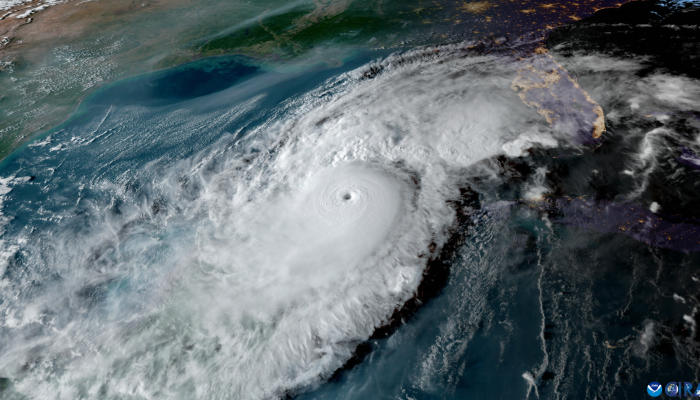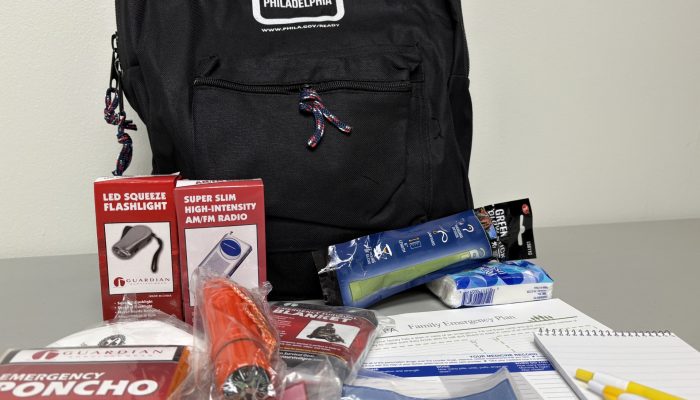Forecasters with the National Oceanic and Atmospheric Administration have predicted an above normal Atlantic hurricane season, which begins June 1 and runs through November 30 this year.
The agency is forecasting a range of 13 to 19 total named storms, with six (6) to 10 expected to become hurricanes, due partly to warmer than average ocean temperatures. Most of the predicted activity is likely to occur during August, September, and October, the peak months of the hurricane season.
You don’t need to live in a coastal community to experience the power of these storms, and it doesn’t take a hurricane to impact your health, home, and bank account.
Tropical storm remnants or a thunderstorm system that produce heavy rain, high wind gusts, lightning, rising waterway levels, hail, and tornadoes can happen inland, away from where a hurricane makes landfall.
The Philadelphia Office of Emergency Management (OEM) encourages residents and businesses to take simple steps now to prepare for the hazards the Atlantic hurricane and severe storm season brings.
“Philadelphia experiences storm damage in the form of flooding, downed trees and electrical wires, and structural damage throughout the city, from Manayunk to Port Richmond, Cobbs Creek to Germantown, and Eastwick to Somerton,” said Dominick Mireles, Director, Office of Emergency Management. “Storms don’t wait, so don’t delay. Stay safe by becoming emergency ready in your home. A prepared Philadelphian makes safer, stronger, and more resilient communities throughout our city. Hazard mitigation planning helps to meet Mayor Parker’s vision of safer, cleaner, and greener by ensuring a whole-of-government interagency approach to all the city’s risks.”
The Office of Emergency Management’s hazard mitigation planning team works to identify and reduce risks in the city. This year, they updated the all-encompassing Hazard Mitigation Plan for the city.
Along with the Hazard Mitigation Plan, they also completed the city’s 2025 Severe Weather Plan, one of OEM’s most utilized emergency response outlines, and held an informational workshop for partners.
The planning team also identified ways to help you be aware and prepared for this severe storm season and beyond.
Follow the Forecast
The Office of Emergency Management’s Regional Integration Center tracks storms as they develop in the Atlantic basin (consisting of the northern Atlantic, Gulf, and Caribbean seas) by increasing communication with the National Weather Service and using tools that predict the path the storm, allowing the city to be aware of and prepare for storms.
The National Hurricane Center (NHC) will issue forecast cone information that includes a depiction of inland tropical storm and hurricane watches and warnings in effect for the continental U.S. The NHC will highlight areas where a hurricane watch and tropical storm warning are simultaneously in effect. You can utilize this tool for the latest information on a potential hurricane along with its probable path and hazards.
Stay Connected to Critical Information
Get the forecast, timing, hazards, and protective action information from the City when a severe storm approaches. Text READYPHILA to 888-777 for free text alerts or visit OEM’s website to customize your free text or emails, including flood forecasts on area waterways. Initial information is now available in 11 languages, including American Sign Language.
The National Weather Service may issue an Advisory, Watch, or Warning if a storm system is producing hazardous weather. These alert products are sent directly to ReadyPhiladelphia enrollees.
Home Safety Planning
Create a family emergency plan that considers the needs of all in your household, including pets.
In case you need to leave your home during an emergency, identify two evacuation options and routes, whether that’s staying with family, friends, or a shelter opened by our office and the American Red Cross.
Additionally, ensure you have all important documents, clothing, essential medications, and a contact list, all of which you can place in an emergency go-bag. Make copies and keep them in a secure password-protected digital space.
Flood Insurance and Property Protection
Assess your flood risk by using the National Flood Insurance Program’s website. Review and update home or rental flood insurance policies by checking with your insurance provider.
Remember, flood insurance is not covered under your standard homeowner or renter’s policy, and it typically takes 30 days for new flood insurance policies to take effect.
Reduce the risks from storm damage around your property by cutting down tree branches, unclogging gutters or storm drains, and securing loose outdoor objects and landscaping.
Find flood mitigation information, including the Guide to Flooding in Philadelphia from the City’s Flood Risk Management Task Force, on the City’s Flood Management Program site.
Before a storm happens, move your valuables, electronics, and appliances off the floor in your basement or the lowest level of your home by using shelving units or plastic storage totes. Move your vehicle to a higher location away from low-lying locations like underground garages or an underpass.
Be a Good Neighbor
See how you can be of assistance to others! Check in on neighbors, especially those who are vulnerable like senior adults, those with access and functional needs, or those who may need help preparing for, getting through, or recovering from a storm.
Health and Safety
Know your local hazards, including flood-prone areas to avoid during or after a storm. You can find waterway flood information on NOAA’s National Water Prediction Service page.
If you encounter flooded roadways, turn around and do not drive through them. Floodwater is murky, debris-filled, and could be fast moving.
Storms can bring down tree limbs and power lines. Never approach a downed power line and always assume they are live. Under a tree, and sometimes even inside a car, is not safe from lightning and strong winds: When thunder roars, go indoors. Call 9-1-1 in an emergency. Read more on who to contact if you see downed trees and wires.




